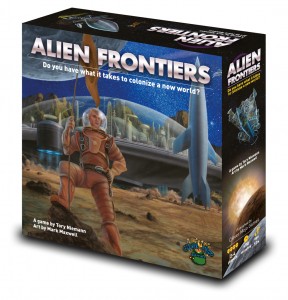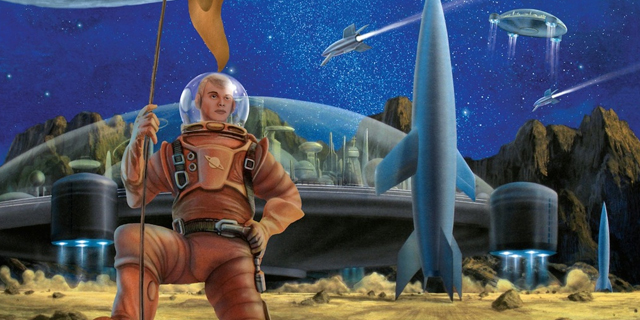Worker-placement is a common mechanic in modern boardgaming, but Tory Niemann’s Alien Frontiers (published in the US by Clever Mojo Games following a successful Kickstarter campaign) adds a seldom-seen twist in that the “workers” you place are rolled dice. Normally I’m not a fan of any game where dice can interfere with my strategy, but Alien Frontiers has a few other features that keep the randomness from detracting from the fun.
 Each player (from two to four) begins with three of their six dice (“ships”) and a number of bases depending on how many are playing. Starting resources are based on turn order. Each player is also dealt one random Alien Technology card, which can be used to manipulate dice, move dice, gain additional resources, or other effects; two cards are worth a point but have no other effect. You can use each tech card only once per turn. Some cards have an alternate effect that cause you to discard them for a different effect; you may only use one such discard power per turn. Most of the non-discard effects require Energy; the only other resource in the game is Ore, which is more useful for building colonies and/or additional ships. Surrounding the planet are various orbital facilities with a specific number of docks; these are where you place your ships, but there are restrictions.
Each player (from two to four) begins with three of their six dice (“ships”) and a number of bases depending on how many are playing. Starting resources are based on turn order. Each player is also dealt one random Alien Technology card, which can be used to manipulate dice, move dice, gain additional resources, or other effects; two cards are worth a point but have no other effect. You can use each tech card only once per turn. Some cards have an alternate effect that cause you to discard them for a different effect; you may only use one such discard power per turn. Most of the non-discard effects require Energy; the only other resource in the game is Ore, which is more useful for building colonies and/or additional ships. Surrounding the planet are various orbital facilities with a specific number of docks; these are where you place your ships, but there are restrictions.
Energy can be obtained via the Solar Collector based on the value of each ship placed there; Ore is collected from the Lunar Mine, but every ship placed there must have the value of the highest ship already placed there (or higher). You can convert Energy into Ore by placing a pair of ships at the Orbital Market, but your trade rate will be determined by their value (from a reasonable 1:1 to an outrageous 6:1). Pairs can also be placed in the Shipyard, which allows you to pay Energy and Ore (based on how many ships you already have) to place a new ship on the Maintenance Bay for future use. Placing a ship on the Alien Artifact allows you to discard the three face-up Tech cards and replace them with new ones if you wish; placing ships totaling eight or more allows you to take a card as long as it isn’t one you already have. A three-ship straight allows use of the Raiders’ Outpost, which lets you either steal four resources (total) from any combination of players or a tech card from one of them. Finally, there are three ways to place bases on the planet: 1) moving a base along the Colonist Hub (one per ship placed, to a maximum of three per round) until it reaches the seventh space, at which point you can pay an Energy and an Ore to place it; 2) placing three identical ships on the Colony Constructor and paying three Ore; or 3) placing a six-value ship on the Terraforming Station and paying one Ore and one Energy — note that any ship placed on the Terraformer is lost (returned to your stock of unavailable ships) on your next round, and you cannot use it at all if you only have three ships.
Placed ships remain in their docks until their player’s next turn, blocking other players from occupying them. (If fewer than four players are playing some spaces are permanently blocked.) The only exception is the Raiders’ Outpost, which allows you to displace existing ships with a higher-valued straight; displaced ships go to the Maintenance Bay. Blocking opponents from desirable locations is a crucial strategy, although there are never any truly “dead” rolls thanks to the Colonist Hub (one set of docks per player) and Solar Converter (eight available docks; if these are all occupied then there aren’t too many ships blocking the other docks). It is worth noting that, unlike other dice-based games, high rolls are not necessarily the best. Sixes are still generally more useful than ones, but the emphasis on pairs and straights helps to alleviate the luck involved, as do the manipulation effects of various tech cards which can add, subtract, exchange, or even flip values before placing them.
The game ends immediately when one player has placed his last base on the board’s planet, which is divided into eight regions named after sci-fi greats like Heinlein, Asimov, and Bradbury. Each region bestows an advantage on whichever player possesses the most bases in it, which can create potent combos. Control of a region is also worth an additional point, as is every base placed. Scores will shift back and forth as players vie for control of the regions, but the more bases that are placed, the closer the game is to ending. In the event of a tie, the player with the most Alien Tech cards wins.
Alien Frontiers takes around 60-90 minutes to play and can be purchased for around $50.




















